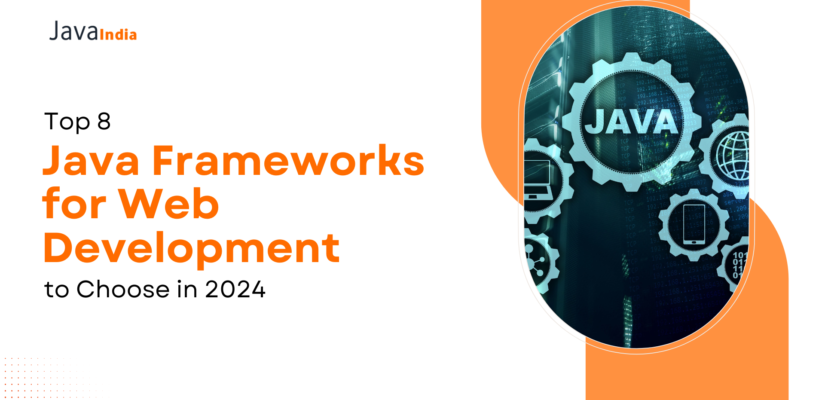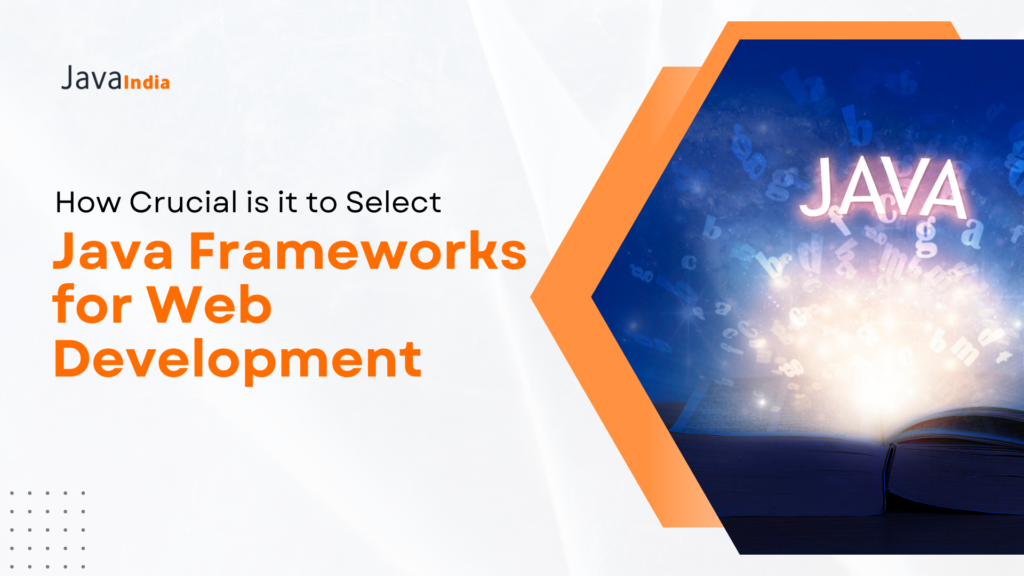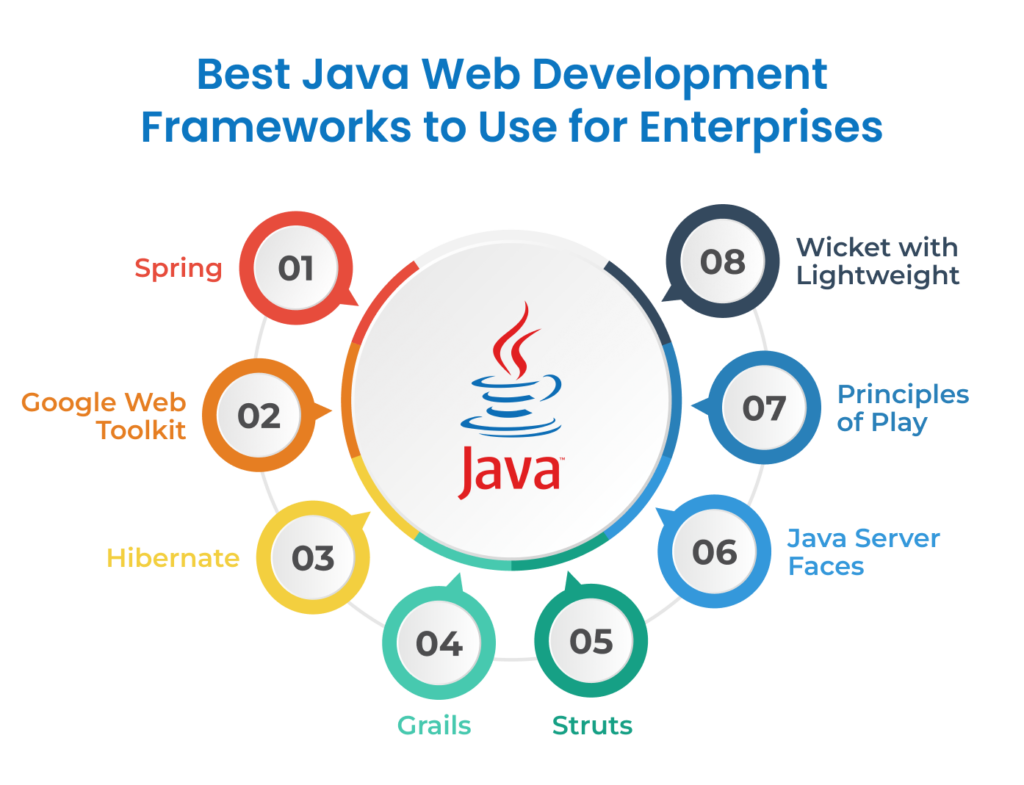
Top 8 Java Frameworks for Web Development to Choose in 2024
Where the world is surging with Metaverse and AI, Is there a reliance on Java? Well, the answer is yes! Java has been the oldest in the programming language realm. So, it becomes a basic understanding the language has maintained itself to be modern. Majorly because of the regular updates and supportive frameworks. These frameworks consist of classes and functions to support websites. So, if you are searching for Java frameworks for web development, let’s dive in.

How crucial it is to select Java frameworks for web development?
Jaca frameworks support the design of structures to develop apps for any platform. So, framework development manages various development stages. It even helps the developers to work on the front-end and back-end with the same frameworks. It becomes essential to choose the best Java frameworks for web development for your website. So, when the programmers work on the same it saves up their time and resources.

Best Java web development frameworks to use for enterprises
Here are some best frameworks you can pick for your Java websites.
Spring
It is one robust, lightweight, and popular web frameworks. Spring works as the most influential Java framework for use. This framework has created a buzz among the developers. Majorly because of the simplicity and speed shown to develop enterprise apps. The Spring MVC and Spring Boot offer great modern and cloud-ready capabilities.
So, it is one of the Java frameworks for web development that supports complex applications. And you can easily build complex and high-performing apps. So, tech giants like Netflix, Google, and Microsoft take this platform.
Features in the Spring:
- Spring offers flexible and comprehensive third-party libraries to support web application development.
- Also, you can start a project quickly with a fat shutdown and optimized performance.
- Spring offers a lightweight container triggered without a web server
- You get effective and easy backward compatibility and testability for your project.
- The incredible support for JDBC improves the productivity by reducing the errors.
- It has a huge ecosystem and community to offer extensive documentation and tutorials.
Google Web Toolkit
It’s a crucial and open-source Java framework used by developers worldwide. Majorly because of its name associated with a reputed platform. Plus, it offers extensive support to build and optimize web applications.
So, this framework offers a highly productive performance for complex applications. You can easily work on the Java J2EE development without expert assistance. It can seamlessly transform Java to JavaScript code. Preferred by the popular Google applications such as AdSense and AdWords.
Features of Google Web Toolkit:
- In the GWT applications, the Google APIs are the popular choices.
- You can easily craft interactive UI without any expert front-end language knowledge.
- And you can build effective web applications to debug easily.
- It helps to easily compile Java to JavaScript code for cross-platforms.
Hibernate
It is a stable and lightweight ORM Java framework. Also, it can easily communicate with databases for convenient working. So, it supports enterprise application development in Java with frequent updates. When you choose Hibernate it offers powerful APIs and useful tools. Such as Mapping Editor, Reverse Engineering, etc. Hibernate is one of the preferred platforms for big companies like IBM, DELL, etc.
Features of Hibernate:
- Hibernate offers complex data and Complex data manipulation with less coding.
- It offers high productivity and portability for seamless web applications.
- You can widely use it for RDBMS and NoSQL databases.
- Hibernate offers command-line tools and IDE plugins for interactive user experience.
Grails
Another dynamic full-stack Java framework with MVC structure. It is quite easy to learn and best suited for the beginner developers. Grails is an object-oriented programming that upgrades the developer’s experience. It is one of the best Java frameworks for web development for potential future relevance. Written in Groovy runs on Java platform for seamless development.
Features of Grails:
- It is quite easy to create tags for the interactive View mode.
- Grails offers built-in support for the RESTful APIs.
- You can easily mix Groovy and Java with Grails.
- And it has the support for rapid development.
- Plus, get the dynamic and impressive configuration features.
Struts
Moving to the next open-source MVC framework to create modern web applications. Structs offer a flexible and beginner-friendly experience. It offers extensive support to enterprise-level projects that offer seamless configuration. Plus, the smart development technique reduces the development process. It comes with numerous plugins REST and AJAX and supports Spring and Hibernate frameworks.
Features of Struts:
- It offers creative themes and templates that offer a faster development process.
- Plus, it extends capabilities even the complex enterprise applications.
- You can easily reduce time and resources for an easier development process.
JavaServer Faces
As discussed, the Struts supports open-source web applications. JSF is seamlessly Oracle to simplify the UI development. Especially for server-side applications it assembles reusable UI components. Also, these Java frameworks for web development have rich libraries and reusable UI components. JSF is a component-based MVC to encapsulates client-side tech stack. And it primarily focuses on the presentation layer to help web developers to create interactive UI.
Features of JavaServer Faces:
- JSF uses front-end tools without much coding overhead.
- So, if you use it you easily improve productivity and consistency.
- Easily enrich the interactive user experience by adding AJAX to validate and invocate.
- Plus, it offers API to represent and manage UI components instead of Java, JSF, and XML.
Play
If you think every Java framework for web application development is quite boring? Then, here is an interesting and unique framework to build interactive applications. Plus, it is stateless, web-friendly, and lightweight MVC architecture. It has high performance because of asynchronous processing. Also, it offers optimized resource consumption for scalable modern apps.
Features of Play:
- You will get the Reactive principles of Play to improve the productivity levels.
- Compile time errors are quite prone in the Play framework to get fixed at the early stages.
- You can easily reload and create simple JAR files for the website.
Wicket
Last, but not least. It is one of the simple Java frameworks for web development with a component-oriented structure. So, you need Java and HTML with absolute zero XML files. It also offers a streamlined and smooth user experience. Also, the feature of the POJO model where simple objects offer OOP concepts. So, these components come in bundles for reusable packages for developers. Plus, you can easily customize images, buttons, forms, containers, behaviors, etc.
Features of Wicket:
- Wicket with lightweight and superfast speed testing for components.
- You get zero XML configuration files with easy unit testing.
- Easily create no back button in bookmarkable projects.
Conclusion: Java is an incredible language with extensive frameworks to build applications. So, it’s necessary to choose the best for your business. Or you can get a Java mobile app development company for your projects.
FAQs
What is the function of a framework in Java?
The Java Framework is a pre-written code collection that Java developers use to create Java applications or web apps. It acts as a skeleton, supporting the developer in the development of an application by creating code.
Which Java framework is the most popular?
For starters, Spring is the most widely used framework for developing Java-based web applications. Spring can also expose RESTful services, has Spring Security (which adds authentication and authorization tools), and can make JDBC connections.
How many Java frameworks exist?
There are over thirty Java frameworks available.
What is the function of the framework?
A framework in computer systems is frequently a layered structure that indicates what kind of programs can or should be constructed and how they would interrelate. Some computer system frameworks additionally incorporate programs, define programming interfaces, or provide programming tools for use with the frameworks.
What are the distinctions between frameworks?
Theoretical and conceptual research frameworks are the two categories of research frameworks.

